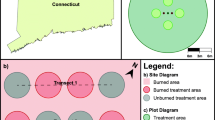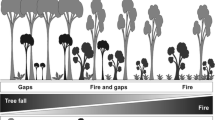Abstract
Fire, which is the dominant disturbance in the boreal forest, creates substantial heterogeneity in soil burn severity at patch and landscape scales. We present results from five field experiments in Yukon Territory, Canada, and Alaska, USA that document the effects of soil burn severity on the germination and establishment of four common boreal trees: Picea glauca, Picea mariana, Pinus contorta subsp. latifolia, and Populus tremuloides. Burn severity had strong positive effects on seed germination and net seedling establishment after 3 years. Growth of transplanted seedlings was also significantly higher on severely burned soils. Our data and a synthesis of the literature indicated a consistent, steep decline in conifer establishment on organic soils at depths greater than 2.5 cm. A meta-analysis of seedling responses found no difference in the magnitude of severity effects on germination versus net establishment. There were, however, significant differences in establishment but not germination responses among deciduous trees, spruce, and pine, suggesting that small-seeded species experience greater mortality on lightly burned, organic soils than large-seeded species. Together, our analyses indicate that variations in burn severity can influence multiple aspects of forest stand structure, by affecting the density and composition of tree seedlings that establish after fire. These effects are predicted to be most important in moderately-drained forest stands, where a high potential variability in soil burn severity is coupled with strong severity effects on tree recruitment.










Similar content being viewed by others
References
Arseneault D. 2001. Impact of fire behavior on postfire forest development in a homogeneous boreal landscape. Can J Forest Res 31:1367–74
Black RA, Bliss LC. 1980. Reproductive ecology of Picea mariana (Mill.) Bsp., at tree line near inuvik, Northwest Territories, Canada. Ecol Monogr 50:331–54
Charron I, Greene DF. 2002. Post-wildfire seedbeds and tree establishment in the southern mixedwood boreal forest. Can J Forest Res 32:1607–15
Choung Y, Lee BC, Cho JH, Lee KS, Jang IS, Kim SH, Hong SK, Jung HC, Choung HL. 2004. Forest responses to the large-scale east coast fires in Korea. Ecol Res 19:43–54
Chrosciewicz Z. 1974. Evaluation of fire-produced seedbeds for jack pine regeneration in central Ontario. Can J Forest Res 4:455–7
Clautice SF. 1974. Spruce and birch germination on different seedbeds and aspects after fire in interior Alaska. MSc thesis, University of Alaska Fairbanks, Fairbanks, AK, USA
Cochran WG, Cox GM. 1992. Experimental designs. New York: Wiley. p 611
Conover WJ. 1999. Practical nonparametric statistics. New York: Wiley. p 584
Coyea MR. 1988. Factors affecting white spruce (Picea glauca) seed germination on burned forest litter. MSc thesis, University of Alberta, Edmonton, Alberta
Duchesne S, Sirois L. 1995. Phase initiale de régénération après feu des populations conifériennes subarctiques. Can J Forest Res 25:307–18
Dyrness CT, Norum RA. 1983. The effects of experimental fires on black spruce forest floors in interior Alaska. Can J Forest Res 13:879–893
Foster DR. 1985. Vegetation development following fire in Picea mariana (black spruce) – Pleurozium forests of south-eastern Labrador, Canada. J Ecol 73:517–34
Foster DR, Knight DH, Franklin JF. 1998. Landscape patterns and legacies resulting from large, infrequent forest disturbances. Ecosystems 1:497–510
Gutsell S, Johnson EA. 2002. Accurately ageing trees and examining their height-growth rates: implications for interpreting forest dynamics. J Ecol 90:153–66
Hedges LV, Gurevitch J, Curtis PS. 1999. The meta-analysis of response ratios in ecology. Ecology 80:1150–6
Herr DG, Duchesne LC. 1995. Jack Pine (Pinus banksiana) seedling emergence is affected by organic horizon removal, ashes, soil, water and shade. Water Air Soil Pollut 82:147–54
Jarvis JM. 1966. Seeding white spruce, black spruce and jack pine on burned seedbeds in Manitoba. Canada Department of Forestry Report. No. 1166, Ottawa, Ontario
Johnson EA. 1992. Fire and vegetation dynamics. Studies from the North American Boreal Forest. Cambridge: Cambridge University Press. p 129
Johnson EA, Fryer GI. 1989. Population dynamics in lodgepole pine-engelmann spruce forests. Ecology 70:1335–45
Johnson EA, Miyanishi K, Kleb H. 1994. The hazards of interpretation of static age structures as shown by stand reconstructions in a Pinus contorta – Picea engelmannii forest. J Ecol 82:923–31
Johnson EA, Miyanishi K, Weir JMH. 1998. Wildfires in the western Canadian boreal forest: landscape patterns and ecosystem management. J Veg Sci 9:603–10
Johnston M, Elliott J. 1998. The effect of fire severity on ash, and plant and soil nutrient levels following experimental burning in a boreal mixedwood stand. Can J Soil Sci 78:35–44
Johnstone JF, Chapin FSI, Foote J, Kemmett S, Price K, Viereck L. 2004. Decadal observations of tree regeneration following fire in boreal forests. Can J Forest Res 34:267–73
Kasischke ES, French NHF, O’Neill KP, Richter DD, Bourgeau-Chavez LL, Harrell PA. 2000. Influence of fire on long-term patterns of forest succession in Alaskan boreal forests. In: Kasischke ES, Stocks BJ, eds. Fire, climate change, and carbon cycling in the boreal forest. Berlin Heidelberg New York: Springer. p 214–38
Keays GM. 1987. Early post-fire succession following a severe fire in Wood Buffalo National Park, Northwest Territories. MSc thesis, University of New Brunswick, Frederickton, New Brunswick
Lavoie L, Sirois L. 1998. Vegetation changes caused by recent fires in the northern boreal forest of eastern Canada. J Veg Sci 9:483–92
Leadem CL, Gillies SL, Yearsley HK, Sit V, Spittlehouse DL, Burton PJ. 1997. Field studies of seed biology. Victoria (BC): British Columbia Ministry of Forests
LeBarron RK. 1945. Mineral soil is favorable seedbed for spruce and fir. Lake States Forest Experiment Station Technical Note 237, St. Paul, Minnesota
Lotan JE, Perry DA. 1983. Ecology and regeneration of lodgepole pine. USDA forest service agriculture handbook no. 606, Washington, DC
Miyanishi K, Johnson EA. 2002. Process and patterns of duff consumption in the mixedwood boreal forest. Can J Forest Res 32:1285–95
Pastor J, Cohen Y, Moen R. 1999. Generation of spatial patterns in boreal forest landscapes. Ecosystems 2:439–50
Pausas JG, Ouadah N, Ferran A, Gimeno T, Vallejo R. 2003. Fire severity and seedling establishment in Pinus halepensis woodlands, eastern Iberian Peninsula. Plant Ecol 169:205–13
Payette S. 1992. Fire as a controlling process in the North American boreal forest. In: Shugart HH, Leemans R, Bonan GB, eds. A systems analysis of the global boreal forest. Cambridge: Cambridge University Press. p 144–69
Rosenberg MS, Adams DC, Gurevitch J. 2000. MetaWin, version 2.0. Sunderland (MA): Sinauer Associates, Inc
Rowe JS. 1983. Concepts of fire effects on plant individuals and species. In: Wein RW, MacLean DA, eds. The role of fire in northern circumpolar ecosystems. Chichester: Wiley. p 135–54
Schimmel J. 1993. On fire: fire behavior, fuel succession and vegetation response to fire in the Swedish boreal forest. PhD thesis, Swedish University of Agricultural Sciences, Umea, Sweden
Schimmel J, Granström A. 1996. Fire severity and vegetation response in the boreal Swedish forest. Ecology 77:1436–50
Sirois L. 1993. Impact of fire on Picea mariana and Pinus banksiana seedlings in subarctic lichen woodlands. J Veg Sci 4:795–802
Swanson DK. 1996. Susceptibility of permafrost soils to deep thaw after forest fires in interior Alaska, USA, and some ecologic implications. Arctic Alpine Res 28:217–27
Turner MG, Romme WH, Gardner RH. 1999. Prefire heterogeneity, fire severity, and early postfire plant reestablishment in subalpine forests of Yellowstone National Park, Wyoming. Int J Wildland Fire 9:21–36
Turner MG, Romme WH, Tinker DB. 2003. Surprises and lessons from the 1988 Yellowstone fires. Front Ecol Environ 1:351–8
Van Cleve K, Chapin FS III, Dryness CT, Viereck LA. 1991. Element cycling in taiga forest: state-factor control. BioScience 41:78–88
Weber MG, Hummel M, Van Wagner CE. 1987. Selected parameters of fire behavior and Pinus banksiana Lamb. regeneration in eastern Ontario. Forestry Chron 63:340–6
Wurtz TL, Zasada JC. 2001. An alternative to clear-cutting in the boreal forest of Alaska: a 27-year study of regeneration after shelterwood harvesting. Can J Forest Res 31:999–1011
Zasada J, Norum RA, Van Veldhuizen RM, Teutsch CE. 1983. Artificial regeneration of trees and tall shrubs in experimentally burned upland black spruce/feather moss stands in Alaska. Can J Forest Res 13:903–13
Zasada JC. 1985. Production, dispersal, and germination of white spruce and paper birch and first-year seedling establishment after the Rosie Creek Fire. In: Juday GP, Dyrness CT, eds. Early results of the Rosie Creek fire research project, 1984. Fairbanks (AK): Agricultural and Forestry Experiment Station, University of Alaska Fairbanks. p 34–7
Zasada JC, Sharik TL, Nygren M. 1992. The reproductive process in boreal forest trees. In: Shugart HH, Leemans R, Bonan GB, eds. A systems analysis of the global boreal forest. Cambridge: Cambridge University Press. p 85–125
Acknowledgements
This research was funded by grants to FSC through the Bonanza Creek LTER program (NSF grant DEB-0080609 and USDA Forest Service grant PNW01-JV11261952-231), grants to JFJ from the Center for Global Change at the University of Alaska and the Northern Research Institute at Yukon College, and graduate fellowships to JFJ from NSERC Canada and the NASA Earth System Science program. The Alaska Division of Forestry provided black and white spruce seed. Access to non-public lands was provided by the US Army at the Fort Greely military base in Delta, and by the Ta’an Kwatchan First Nation for the sites at Fox Lake. We are grateful to the following people for research support: Wim Arp, Eliza Bettinger, Erica Close, Monique Heijmans, Jonathan Henkelman, Heidi Kristensen, Kim Jansen, Ben Legler, Sasha Oystryk, and Heather Smith. We also thank Syndonia Bret-Harte and two anonymous reviewers for providing helpful feedback on the manuscript.
Author information
Authors and Affiliations
Corresponding author
Rights and permissions
About this article
Cite this article
Johnstone, J.F., Chapin, F.S. Effects of Soil Burn Severity on Post-Fire Tree Recruitment in Boreal Forest. Ecosystems 9, 14–31 (2006). https://doi.org/10.1007/s10021-004-0042-x
Received:
Accepted:
Published:
Issue Date:
DOI: https://doi.org/10.1007/s10021-004-0042-x




